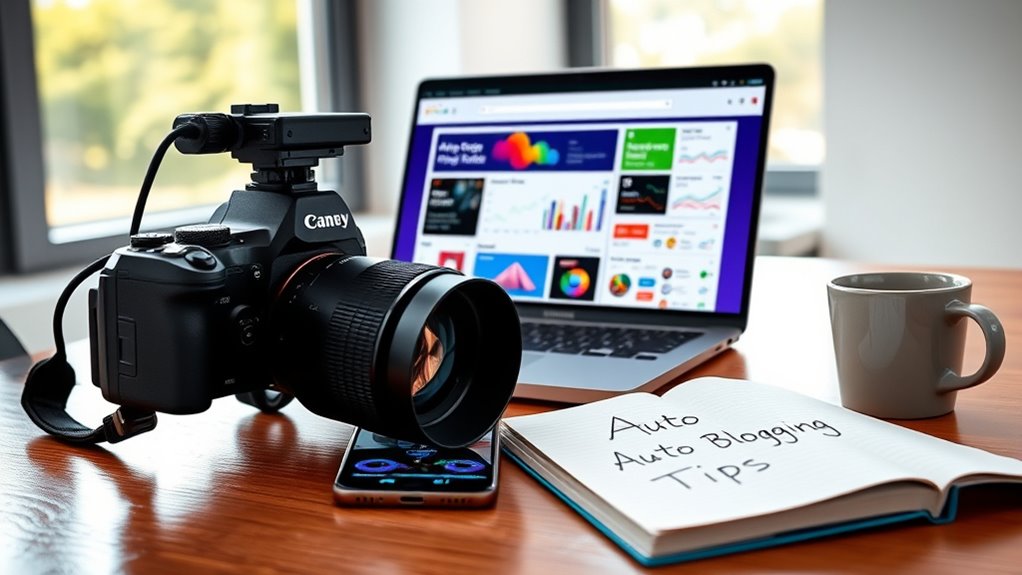Auto blogging is a process that automates content creation and publishing on your website using specialized tools or algorithms. It helps you save time, maintain a steady flow of posts, and attract more visitors by leveraging keyword-rich content and multimedia. While it boosts your site’s authority and traffic, it also involves managing quality and avoiding duplicate or low-quality posts. If you continue exploring, you’ll discover how to make auto blogging work best for your goals.
Key Takeaways
- Auto blogging automates content creation and publishing using specialized software or algorithms to save time and effort.
- It involves sourcing, generating, and scheduling articles automatically to maintain consistent website updates.
- Auto blogging supports monetization through high-volume, keyword-rich posts and passive income streams.
- Customization options include optimizing content length, tone, keywords, and design for better engagement.
- Challenges include maintaining content quality, avoiding duplicate issues, and ensuring relevance and originality.
Understanding Auto Blogging and Its Purpose

Auto blogging is a technique that automatically generates and publishes blog content using specialized software or algorithms. Its primary goal is to streamline content creation, allowing you to maintain a consistent publishing schedule without manual effort. This approach supports content monetization by producing volume traffic through regular, keyword-rich posts. When starting, niche selection is vital; choosing a specific topic helps target a dedicated audience and improves search engine rankings. Auto blogging enables you to automate content from various sources based on your chosen keywords and industry focus. This method saves time, increases site activity, and can generate passive income through ads or affiliate marketing. Understanding its purpose helps you leverage auto blogging effectively, especially when combined with strategic niche selection. Additionally, incorporating elements like high-quality content and relevant multimedia can further enhance engagement and SEO performance.
How Automated Content Creation Works

Automated content creation starts by sourcing ideas through keyword research, competitor analysis, and content templates, helping you stay relevant and SEO-friendly. Scheduling tools then streamline publication, ensuring your posts go live consistently without manual effort. By customizing and optimizing content for your target audience, you can enhance engagement and maintain quality across all media types.
Content Sourcing Methods
Content sourcing methods form the backbone of automated blogging, enabling you to gather and publish fresh content with minimal manual effort. By leveraging tools like RSS feeds, you can pull updates from reputable sources in your niche, ensuring timely content that appeals to your target audience. AI-generated content allows you to produce unique articles tailored to your niche targeting, helping you maximize content monetization without risking duplicate penalties. Content curation combines automated or manual selection of articles from various sources, enriching your blog with diverse perspectives while maintaining relevance. Video-to-article conversion transforms video content into SEO-friendly blog posts, expanding your reach. Using a hybrid approach, you can blend these methods to create a scalable, engaging blog that attracts visitors and boosts monetization opportunities efficiently. Additionally, understanding the importance of appliance integration can help you incorporate smart devices into your content strategy, making your blog more relevant to tech-savvy audiences.
Automation Scheduling Techniques
Scheduling is the key to keeping your blog consistently fresh and engaging without constant manual effort. By using scheduling automation, you can automate content orders ahead of publish dates, ensuring a steady flow of posts. This prevents last-minute rushes and maintains quality control. Align your content calendar with marketing campaigns for coherence and monitor scheduled content regularly to stay on track. Managing multiple content schedules for different writers or streams helps diversify your output without overload. Use tools that connect content creation, publishing, and analytics platforms via APIs for seamless updates. Here’s a quick look at some techniques: Scheduling feature sets order placement dates, not content readiness dates. Incorporating content management systems can further streamline your workflow and reduce errors.
Customization and Optimization
Customization and optimization are at the heart of effective auto blogging, allowing you to tailor content creation to fit your brand and audience. You can set parameters like article length, tone, language, and specific keywords to boost user engagement and guarantee your content aligns with your goals. Visual design elements, such as templates and formatting, help maintain a consistent look that appeals to your readers. Optimization techniques include targeting high-potential search terms, leveraging AI-generated drafts for quality, and refining content based on performance analytics. By integrating keyword research, content curation, and SEO tools, you can improve rankings and keep your site fresh. These features give you control over content quality, relevance, and visual appeal, making your auto blogging efforts more effective. Automation reduces manual effort and allows for more consistent content updates, which can positively impact your site’s visibility and authority. Additionally, understanding content management best practices ensures that your automated posts remain aligned with your overall strategy and audience preferences.
Different Types of Auto Blogging Systems

Auto blogging systems come in various types, each designed to automate different aspects of content creation and publishing. Some plugins, like WP Turbo and MultiPress, focus on sourcing content from platforms like Amazon, eBay, or keyword lists, streamlining niche targeting. Others, such as AutoBlogged and WP Robot, emphasize content generation and syndication, helping you implement diverse monetization strategies. AI-powered tools like Autoblogging.ai and Arvow enhance content quality, SEO optimization, and customization, ensuring your auto blog appeals to your target audience. These systems often support integration with popular CMS platforms like WordPress, Shopify, and Wix, making it easier to manage multiple channels. Choosing the right auto blogging system depends on your niche, content needs, and monetization goals. Additionally, understanding support hours for services can help you troubleshoot issues and optimize your blogging workflow.
Key Benefits of Using Auto Blogs

Using auto blogs offers numerous key benefits that can considerably enhance your content strategy. They save you time by automating content creation, allowing you to focus on marketing, audience engagement, and strategic planning. Auto blogging ensures consistent and frequent content updates, which help retain your audience and improve SEO rankings through ongoing content curation. You can manage multiple blogs effortlessly, thanks to scheduling features that keep your sites active even during busy periods or holidays. This steady flow of content attracts more visitors, boosts website authority, and opens up monetization opportunities. Plus, auto blogs are cost-effective, reducing the need for hiring additional writers while maintaining a high volume of quality posts. Overall, auto blogging streamlines your workflow and strengthens your online presence. Additionally, they help maintain content relevance by continuously updating your sites with fresh material.
Common Challenges and Risks Involved

You need to be aware that auto blogging can lead to content that lacks originality and struggles with quality, risking SEO penalties. Duplicate or near-identical posts can harm your site’s credibility and search rankings. Without careful oversight, your blog could become riddled with outdated or derivative material that fails to engage readers. Automated content often lacks human critical analysis and contextual understanding, which are essential for maintaining high standards. Moreover, reliance on automation may overlook important seasonal variations that enrich camping experiences or environmental considerations needed for sustainable practices.
Quality and Originality Concerns
While automation can streamline content production, it often raises significant concerns about quality and originality. Automated posts tend to lack nuance in language, tone, and context, resulting in generic or robotic writing that can turn off readers. You’ll face creativity limitations, as auto-generated content relies heavily on existing data and templates, making posts repetitive and uninspired. This can cause your audience to disengage due to predictability. Additionally, the absence of original perspectives weakens your blog’s unique voice and hampers differentiation in competitive niches. Search engines prioritize original content, so low originality can hurt your rankings and organic traffic. Without human oversight, your blog risks becoming bland, losing credibility, and ultimately damaging your long-term growth prospects. Furthermore, a lack of analytical thinking can impede your ability to assess and improve content quality over time.
SEO and Duplicate Content
Automated content generation can substantially boost efficiency, but it also introduces serious SEO challenges, particularly with duplicate content. Search engines penalize or lower rankings for duplicate or near-duplicate content, which reduces your traffic potential. Google’s algorithms aim to filter out repeated pages, making it harder for auto-blogged posts with similar info to rank well. Duplicate content can lead to manual or algorithmic search engine penalties, decreasing your domain authority or even removing your site from search indexes. It also dilutes link equity across multiple URLs, weakening SEO signals. Excessive duplication wastes crawl budget, causing search engines to prioritize duplicate pages over new, unique content. To avoid these risks, you must implement strategies like canonical tags and content variation to protect your SEO and maintain visibility. Additionally, understanding search engine algorithms can help you adapt your strategies to stay compliant and optimize your content effectively.
Tools and Software for Auto Blogging

A variety of tools and software platforms now make auto blogging more efficient and scalable than ever before. These tools help you streamline content creation, optimize for search engines, and automate publishing across multiple platforms—perfect for niche targeting and content monetization. For example, Byword AI automates workflow from keyword research to article generation, supporting SEO and scheduled multi-platform publishing. SEOmatic focuses on creating bulk content to drive traffic and scale your efforts. Spreadbot offers AI-powered, fully integrated solutions for scalable, hands-free publishing. Aksu provides customizable SEO features, multilingual support, and automated WordPress publishing, ideal for small businesses. Jasper and Copy.ai help with rapid draft creation, making quick content development easier. Additionally, content generation techniques are continually evolving, enabling even more sophisticated auto blogging strategies. These platforms empower you to grow your blog efficiently with minimal manual effort, saving hours of work and improving overall productivity.
Strategies for Maintaining Content Quality

Maintaining high content quality is essential for the success of your auto blog, especially as automation tools handle much of the creation process. Focus on safeguarding content authenticity by implementing a thorough quality control checklist that covers brand voice, fact-checking, SEO integration, grammar, and link validity. Conduct human editorial reviews to ensure relevance, flow, and accuracy, adding original insights automation can’t produce. Use a multi-step review workflow—automated drafts, human editing, and final inspections—to uphold standards. Remember, automation should assist, not replace, human oversight to preserve ethical considerations and reader trust. Regular post-publication audits help catch errors and outdated info, maintaining credibility. Prioritizing content authenticity and ethical considerations ensures your auto blog remains valuable and trustworthy to your audience. Content quality control is vital to prevent robotic or low-value content from undermining your reputation.
Practical Applications Across Industries

Practical applications of auto blogging span across various industries, transforming how businesses create and distribute content. It boosts Content Monetization by generating SEO-optimized product descriptions, reviews, and niche-specific posts that attract organic traffic. Industry Trends show automation’s role in handling large inventories and supporting seasonal campaigns through platforms like Shopify. You can automate blog posts that inform customers about trends, usage tips, and comparisons, increasing engagement and conversions. Auto blogging also streamlines content creation for digital marketing, enhancing search rankings and maintaining fresh content across multiple platforms. It enables scalable revenue streams in niches like travel, tech, and health through targeted, timely content. Additionally, it supports eco-conscious industries by automating updates on sustainable products and innovations, aligning with current Industry Trends toward green solutions. SEOmatic’s automation capabilities significantly improve efficiency by creating large volumes of search-optimized content with minimal manual effort.
Future Developments in Auto Blogging Technology

Advancements in auto blogging technology are revolutionizing how content is created and managed, making automation more intelligent and personalized than ever before. Future systems will better address AI ethics by implementing bias mitigation strategies, ensuring fair and accurate content. As AI becomes more sophisticated, it’ll generate highly relevant, audience-tailored posts that boost engagement and retention. Enhanced algorithms will adapt in real time based on user interactions, while multimedia tools like AI-driven visuals and videos will enrich blog content automatically. These innovations will also streamline workflows through seamless integration with CMS and social media platforms. To maintain quality, balancing automation with human oversight remains essential, especially as ethical concerns around misinformation and copyright grow. Ongoing research in AI ethics is critical to developing standards that foster responsible content creation at scale. The future of auto blogging promises smarter, more responsible content creation at scale.
Tips for Getting Started With Auto Blogging

Getting started with auto blogging requires selecting the right platform and tools that suit your needs. WordPress is the top choice because of its flexibility, plugins, and customization options. Choose a hosting provider tailored for WordPress to enhance site performance and reliability. Install essential plugins like SEO tools, RSS feed parsers, and scheduling features to automate posting. Consider auto blogging tools such as WP RSS Aggregator or Auto Blog Starter for seamless content import and publishing. Evaluate AI content generation tools to create keyword-optimized articles, boosting content monetization and user engagement. To deepen your understanding, focus on:
- Curating reputable RSS feeds
- Regularly reviewing content sources
- Using filters for relevant topics
- Rewriting or spinning content
- Scheduling posts for optimal engagement
Auto blogging is capable of producing up to 1,000 SEO-optimized articles with a single click, making it a powerful tool for scaling content creation efficiently.
Frequently Asked Questions
Is Auto Blogging Legal and Compliant With Copyright Laws?
Did you know that 65% of copyright infringement cases involve unintentional misuse? Auto blogging can be legal if you follow copyright concerns and guarantee legal compliance. You need to use permissioned or public domain content, provide proper attribution, and avoid duplicate content. Regularly reviewing your auto-generated posts and consulting legal experts help you stay within copyright laws, protecting your blog from potential legal issues.
How Can I Prevent My Auto Blog From Being Considered Spam?
To prevent your auto blog from being considered spam, focus on maintaining content originality by creating unique, valuable articles. Use natural language that mimics human writing to avoid spam filtering algorithms. Avoid spammy keywords and include relevant, contextual links. Regularly updating content keeps your site fresh, while implementing spam filtering techniques like CAPTCHA and spam word filters helps block unwanted submissions. These steps guarantee your auto blog stays legitimate and user-friendly.
What Are the Best Practices for SEO in Auto Blogging?
You should focus on SEO best practices by prioritizing content originality and keyword optimization. Use a single primary keyword per post to boost relevance, and naturally integrate related long-tail keywords for better visibility. Craft SEO-friendly titles and meta descriptions, and structure your content with clear subheadings. Regularly review and update your auto-generated posts, adding unique insights to maintain originality and improve search rankings, ensuring your blog stays relevant and engaging.
Can Auto Blogging Help Improve Engagement and Audience Loyalty?
Did you know that consistent, fresh content can boost audience interaction by up to 70%? Auto blogging helps improve engagement and audience loyalty by delivering regular updates tailored to your target viewers. While it saves time, focus on maintaining content quality to keep your readers interested and involved. Automated posts can enhance loyalty if they provide real value, but avoid sacrificing originality, which is key to fostering a dedicated community.
How Do I Choose the Right Auto Blogging Software for My Needs?
To select the right auto blogging software, focus on how well it offers content customization options like tone, keywords, and structure to match your niche. Check for plugin compatibility with your existing platforms like WordPress or Medium to guarantee seamless integration. Prioritize user-friendly interfaces, automation features, SEO tools, and scalable plans. Also, consider support and community resources to help you maximize the software’s potential and grow your blog effectively.
Conclusion
Auto blogging can boost your online presence, saving time and effort. With over 60% of marketers using automated tools, it’s clear auto blogs are transforming content creation. By understanding how they work and managing potential risks, you can harness their power effectively. Stay updated on emerging technologies to keep your blog competitive. Embrace auto blogging wisely, and you’ll open new growth opportunities, making your digital efforts smarter and more efficient.









